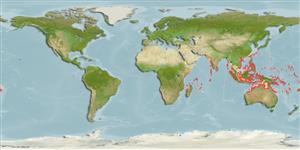>
Eupercaria/misc (Various families in series Eupercaria) >
Lethrinidae (Emperors or scavengers) > Lethrininae
Etymology: Lethrinus: Greek, lethrinia, a fish pertaining to genus Pagellus.
More on author: Valenciennes.
Environment: milieu / climate zone / depth range / distribution range
Ecologia
marino associati a barriera corallina; non migratori; distribuzione batimetrica 4 - 35 m (Ref. 90102). Tropical; 30°N - 21°S
Indo-West Pacific: Sri Lanka to the Marshall and Solomon islands, north to the Ryukyu Islands, south to northern Australia.
Size / Peso / Age
Maturity: Lm ? range ? - ? cm
Max length : 35.0 cm TL maschio/sesso non determinato; (Ref. 2295); common length : 29.0 cm SL maschio/sesso non determinato; (Ref. 37816)
Spine dorsali (totale): 10; Raggi dorsali molli (totale): 9; Spine anali 3; Raggi anali molli: 8. Body is brown or tan, with scattered irregular small black blotches, a large oblong black blotch below soft-rayed portion of dorsal fin and bordering below the lateral line. The fins are pale or pinkish.
Solitary or in groups (Ref. 90102). Inhabits shallow seagrass beds, reef flats, lagoons, and sandy areas near coral reefs. Feeds on benthic invertebrates and small fish. Also caught with beach seines and handlines and is marketed fresh (Ref. 9775).
Life cycle and mating behavior
Maturità | Riproduzione | Deposizione | Uova | Fecundity | Larve
Carpenter, K.E. and G.R. Allen, 1989. FAO Species Catalogue. Vol. 9. Emperor fishes and large-eye breams of the world (family Lethrinidae). An annotated and illustrated catalogue of lethrinid species known to date. FAO Fish. Synop. 125(9):118 p. Rome: FAO. (Ref. 2295)
IUCN Red List Status (Ref. 130435)
Threat to humans
Harmless
Human uses
Pesca: scarso interesse commerciale
Informazioni ulteriori
Nomi ComuniSinonimiMetabolismoPredatoriEcotossicologiaRiproduzioneMaturitàDeposizioneSpawning aggregationFecundityUovaEgg development
BibliografiaAcquacolturaProfilo di acquacolturaVarietàGeneticaElectrophoresesEreditarietàMalattieElaborazioneNutrientsMass conversion
Strumenti
Special reports
Download XML
Fonti Internet
Estimates based on models
Preferred temperature (Ref.
123201): 26.2 - 28.9, mean 27.9 °C (based on 396 cells).
Phylogenetic diversity index (Ref.
82804): PD
50 = 0.5000 [Uniqueness, from 0.5 = low to 2.0 = high].
Bayesian length-weight: a=0.01318 (0.00806 - 0.02156), b=3.00 (2.87 - 3.13), in cm total length, based on LWR estimates for this species & Genus-body shape (Ref.
93245).
Trophic level (Ref.
69278): 4.0 ±0.64 se; based on food items.
Generation time: 1.9 ( na - na) years. Estimated as median ln(3)/K based on 2
growth studies.
Resilienza (Ref.
120179): Alto, tempo minimo di raddoppiamento della popolazione meno di 15 mesi (K=0.5-0.7).
Fishing Vulnerability (Ref.
59153): Low vulnerability (25 of 100).
Nutrients (Ref.
124155): Calcium = 58.4 [39.8, 93.9] mg/100g; Iron = 0.962 [0.622, 1.426] mg/100g; Protein = 20.4 [17.8, 22.6] %; Omega3 = 0.139 [0.096, 0.203] g/100g; Selenium = 36.7 [22.7, 62.9] μg/100g; VitaminA = 31.3 [6.7, 176.2] μg/100g; Zinc = 2.14 [1.59, 2.81] mg/100g (wet weight);
